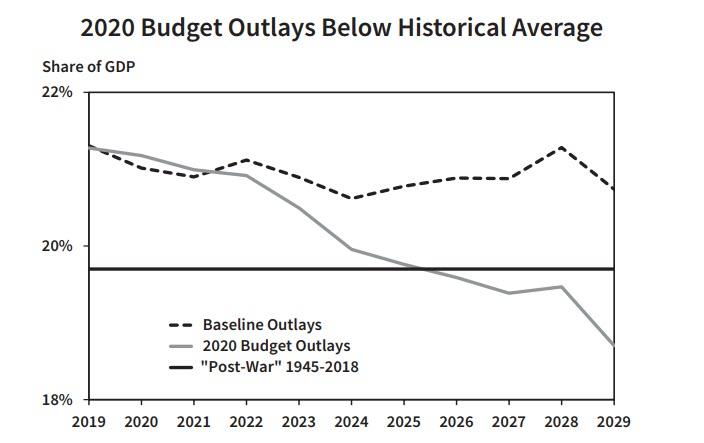Submitted by Joseph Carson, former director of Global Economic Research, Alliance Bernstein.
President Trump’s 2020 budget proposal has many story lines, but the main story is the “chaos” in the numbers. Not only do the economic forecasts appear to be overly optimistic when compared to consensus estimates, they contradict two of the basic tenets of the Administration’s fiscal strategy in that “tax cuts will produce faster growth” and “tax cuts will pay for themselves in the longer run.”
At first glance, the 2020 budget does appear to adhere to the story line that tax cuts generate faster growth. After recording 2.9% growth in 2018, the Administration confidently predicts 3%, or a little better, until 2024 and then growth inching down to 2.9% in 2025 and 2.8% thereafter.
Yet, what is confusing about the economic forecasts is that the Administration is predicting as much growth in 2025 as what occurred in 2018, but last’s year economic growth was boosted by business and individual tax cuts and in 2025 individual tax cuts expire and full expensing of business equipment had already expired in 2024.
So the question the Administration needs to answer, “Do tax cuts trigger faster growth, or don’t they? ” Their own economic forecasts contradict their main argument on tax cuts as they are forecasting as much growth when taxes rise as when they fall.
The other controversial issue is how the faster growth scenario generates more revenue growth. Again, here too the Administration’s forecast on revenue runs counter to their basic premise. To be sure, in 2017, the year before tax cuts took effect, revenue as percent of GDP hit 17.4%. And according to the Administration’s forecast that ratio of revenue to GDP is not reached again until 2024.
Yet, reaching that revenue threshold in 2024 is not because of economic growth, but instead it’s due to a double-digit surge in corporate tax payments as the full expensing of business equipment expires. The ratio of revenue to GDP moves up even more so in 2025, jumping to 17.6%, as the tax rates on individuals reverse back to levels that existed in 2017.
So a fair read of the Administration’s economic and budget forecasts is that tax cuts don’t generate faster growth and tax increases lower the deficits. Confused? So am I.
via ZeroHedge News https://ift.tt/2Hgfmyl Tyler Durden
